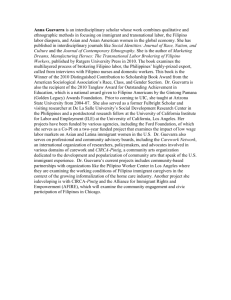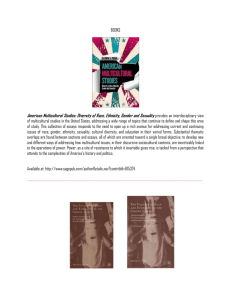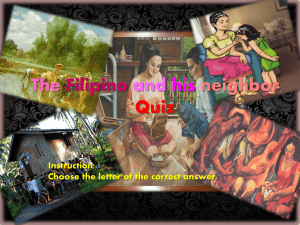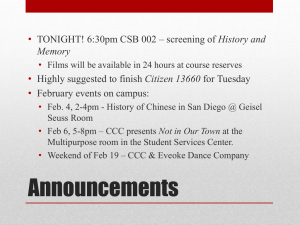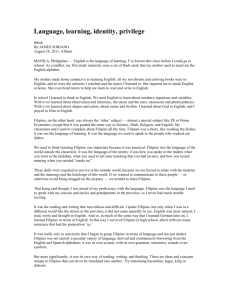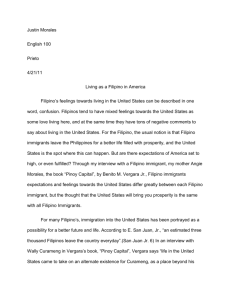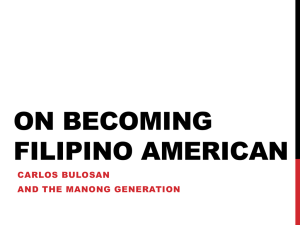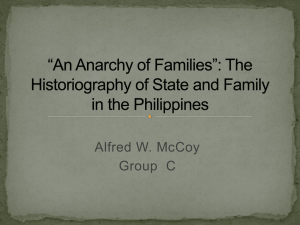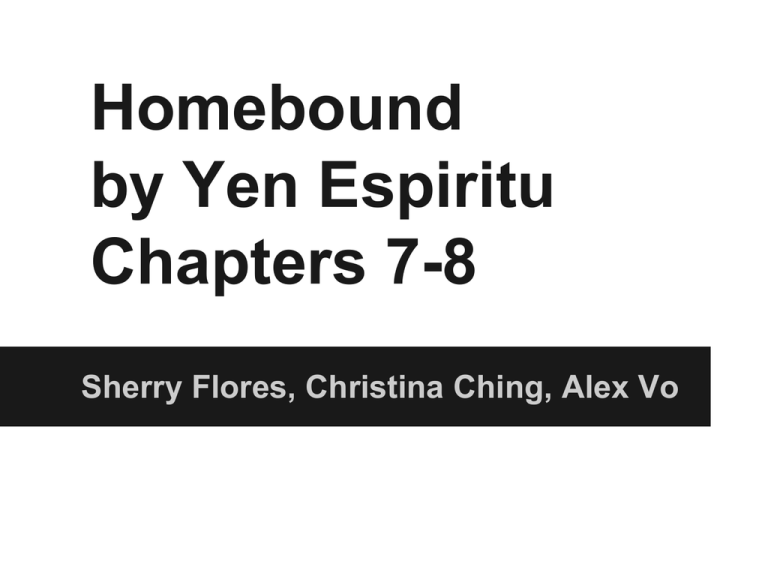
Homebound
by Yen Espiritu
Chapters 7-8
Sherry Flores, Christina Ching, Alex Vo
CHAPTER 7
"We Don't Sleep Around Like White Girls Do"
•
Divergence from the slanderish remarks about
sexuality of racialized women
•
•
Define what is an "American"
Different values and morals between "white"
Americans
•
•
Sexuality
Double standard (171-2)
CHAPTER 7: WHITENESS
AS DEFAULT
•
Whiteness and white people are seen as the default American and
American experience.
•
•
•
In U.S. racial discourse and practices, unless otherwise specified,
"Americans" means "white"...US immigration exclusion acts, naturalization
laws, and national culture have simultaneously marked Asians as the
inassimilable aliens and whites as the quintessential Americans.
"they equate American with white and often use these two terms
interchangeably...others speak about 'American ways,' 'American culture,'
or 'American lifestyle' when they really mean white American ways, culture
and lifestyle." - p. 159
Other Asian Americans have conflated American and white.
FILIPINO RESISTANCE TO
WHITENESS
• "Historically, the sexuality of racialized women has been systematically
demonized and denigrated by dominant or oppressor groups to justify and
bolster nationalist movements, colonialism, and/or racism. But as these
narratives indicate, racialized groups also look down on the morality of
white women as a strategy of resistance - a means of asserting a morally
superior public face to the dominant society.
• "largely gendered discourse of morality as one strategy to mark and
decenter whiteness and to locate themselves above the dominant group,
demonizing it in the process"
• In so doing, they racialize whiteness (and explicitly white women) by
marking it as sexually and morally deviant
WHO BEARS THE GENDERED COSTS?
•
•
•
"The ideal "Filipina," then, is partially constructed out of the community's
conceptualization of white women. She is everything they are not: she is sexually
modest and dedicated to her family; they are sexually promiscuous and uncaring.
Within the context of the dominant culture's pervasive hypersexualization of Filipina
women, the cosntruction of tthe "ideal" Filipia- as family oriented and chaste-can be
read as an effort to reclaim the morality of the community."
"In other words, these women were sexually promiscuous because they had
assumed the sexual mores of white women. This characterization allows my
respondents to symbolically disown the Filipina "bad girl" and, in so doing, to uphold
the narrative of Fiipina sexual virtuosity and white female sexual promiscuity."
"Capitalizing on this superfemme, mail-order bride agencies market Filipinas as
"'exotic, subservient wife imports' for sale and as alternatives for men sick of
independent 'liberal' Western women."
CHAPTER 7
•
What are the racialized and gendered consequences of
these constructions for Filipinas?
"immigrant women, particularly young daughters, are
expected to comply with male-defined criteria of what
constitutes "ideal" feminine virtues...Filipino immigrant
parents police their daughters' behaviors in order to
safeguard their sexual innocence and irginity...as the
designated 'keepers of the culture,' immigrant women
and their behavior come under intensive scrutiny from
both men and women of their own groups and from U.S.
born Americans.” (167)
THEMES
CHAPTER 7
Morals
What is female morality?
THEMES
CHAPTER 7
Morals
•
•
What is female morality?
o
Women's dedication to their families and sexual
restraint (160)
o
Revolves around family life and relations
Women's self-worth
o
"...womanhood is idealized as the repository of tradition, the
norms that regulate women's behaviors become a means of
determining and defining group status and boundaries" (160).
THEMES
CHAPTER 7
Morals cont.
•
Family values
o
Reinforces patriarchy through sanctioning women's
behavior and purity
o
Double standard
o
Filipina chastity has the effect of reinforcing
masculinity and patriarchal power of national and
ethnic-respect (158)
CHAPTER 8
"What of the Children?"
•
•
•
Second-generation Filipinos
Racial and ethnic discrimination
Growing up
o
•
•
•
o
Multiracial neighborhoods
Cross-racial friendships vs. negative racial encounters
Filipino standards
o
Not accepting of FOBs
Attempt to assimilate
o
loss of culture and claiming to be an American
Black and white
"What of the Children?"
THEMES
• Identity as a constant negotiation
• Family relations
• Home-making
• Intersectionality
Family Relations
•
•
•
Family as a site of not only support but also
violence
Family as a site of intense conflict and
oppressive demands in immigrant lives
Survival strategies and coping mechanisms
o
o
"trading stories"
rebellion
Identity as a constant
negotiation
• Identity as not fixed or singular, but multiple,
•
overlapping, dynamic and hybridized
Importance of societal productions of
enduring categorical distinctions in identity
formation
Identity crisis and a longing to be accepted
o Dialogue of domination
o Similarities and parallels to American Son
o
Identity as a constant
negotiation
“When we arrived in San Diego in 1976, I attended
Montgomery High School in South San Diego. I was happy to
be there because I saw many Filipino faces that reminded me
of home…To my surprise, I offended many Filipinos because I
was an “FOB”—“fresh off the boat.” I was ridiculed because
my accent reminded them of their parents. It was their shame
coming out at my expense. I was a reminder of the image
they hate, part of themselves. The overt racism from the
Filipino Americans broke my heart….So I had very few
Filipino friends in high school, not because I didn’t want to be
friends with them, but because they didn’t want to be friends
with somebody who was their own but not really theirs.” (183)
Identity as a constant
negotiation
•
“Basically, it was so much going back and forth that
sometimes I lost myself. What the hell are these Filipinos
doing? What the hell are these white people doing? So I
was bouncing back and forth, and in trying to
understand, I got caught up in a lot of things….Since I
wasn’t a part of either group, I didn’t quite fit in either
model. I got really lost and I got involved in alcohol,
drugs, and gangs. I just got into it, basically trying to
understand what didn’t really make much sense” (192)
Filipino immigrant children living with paradoxes
(uneasy and conflicting relationships)
Intersectionality and
Home-making
•
•
Home, however nurturing and comforting, is
undoubtedly established as an exclusive domain
of a few
Expanding notion of home through cross-racial
relationships
o
•
Intersection of different cultures creates new social
relations and identities
Importance of historical processes of material
exclusion and differentiation in creating subjects
o
Racial and economic subordination leading to a
narrative of shared experiences
QUESTIONS/CRITIQUES
•
•
Our group believes Espiritu's analysis, while elaborate
in some analysis of gender, race and sexuality, fails to
include any salient analysis of queer sexuality within
Filipino communities in San Diego. Are there other ways
that Espiritu expand her areas of study and research?
Throughout Espiritu's book, the point of family and
home constantly being negotiated sources of support
and violence for communities is made. How can we
improve upon notions of family and home so they are
not so violent? Is it even possible for home and family to
be negotiated in non-violent ways?

